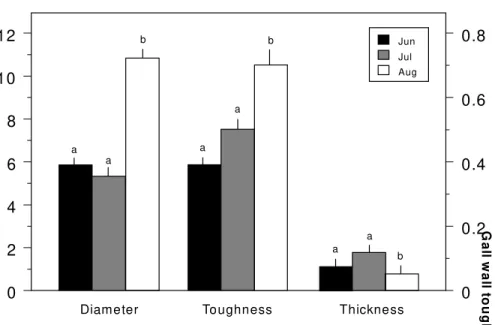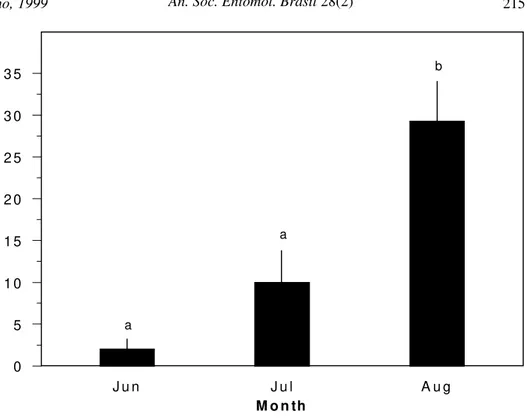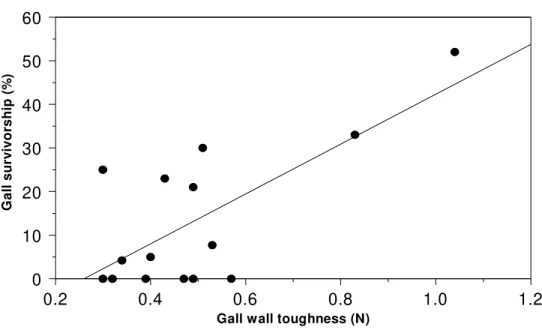ECOLOGY, BEHAVIOR AND BIONOMICS
Cynipid Gall Growth Dynamics and Enemy Attack: Effects of Gall
Size, Toughness and Thickness
GERALDO W. FERNANDES, MÁRIO M. ESPÍRITO-SANTOAND MAURÍCIO L. FARIA
Ecologia Evolutiva de Herbívoros Tropicais/DBG, ICB/Universidade Federal de Minas Gerais, Caixa postal 486, 30161-970, Belo Horizonte, MG, Brasil.
An. Soc. Entomol. Brasil 28(2): 211-218 (1999)
Dinâmica de Crescimento de um Cinipídio e Ataque por Inimigos Naturais: Efeitos do Tamanho, Dureza e Espessura da Galha
RESUMO- Insetos galhadores desenvolveram várias estratégias para evitar ou reduzir o ataque por inimigos naturais, tais como maior espessura da parede no início de formação, e maior diâmetro e dureza da parede em estágios posteriores do desenvolvimento. Neste estudo, analisamos a eficiência de cada um desses parâmetros na redução da mortalidade das galhas de Atrusca caprone Weld (Hymenoptera: Cynipidae) em Quercus turbinella Greene (Fagaceae), durante os três meses de seu desenvolvimento (junho-agosto). O diâmetro e a dureza das galhas aumentaram do primeiro para o terceiro mês de estudo (ANOVA, diâmetro: F = 88.73, p < 0.0001; ANOVA, dureza: F = 26.13, p < 0.0001). Entretanto, a espessura das galhas apresentou um aumento de junho para julho, diminuindo de julho para agosto (ANOVA, F = 35.84, p < 0.0001). A análise de regressão linear múltipla mostrou que apenas a dureza das galhas influenciou a susceptibilidade das larvas ao ataque por parasitóides (r2 = 0.52, F = 13.84, p < 0.01, n = 15). A sobrevivência das galhas foi elevada no primeiro mês, diminuindo com o tempo, provavelmente devido à menor dureza da parede. Estes resultados sugerem que o primeiro mês seja crítico para o estabelecimento das galhas, sendo que galhas não parasitadas neste estágio são menos suscetíveis a um ataque posterior.
PALAVRAS CHAVE: Insecta, galhador, Atrusca caprone, parasitóides, Quercus turbinella, janela de vulnerabilidade. ABSTRACT- Galling insects have developed many strategies to preclude or
35.84, p < 0.0001). Gall survivorship was only 2 % in June, increasing to 10 % in July and to 29.3 % in August. Multiple regression analyses showed that only gall wall toughness influenced gall susceptibility to parasitoid attack (r2 = 0.52, F = 13.84, p < 0.01). Gall survivorship was very low in the first month due probably to low wall toughness, which led to a higher success of oviposition by parasitoids during this phase. These results suggest that the first month is criti-cal to gall establishment, and the galls which are not parasitized at this stage are less likely to be attacked later.
KEY WORDS: Insecta, gall development, parasitoids, Atrusca caprone, win-dow of vulnerability, Quercus turbinella.
The induction of galls by insects has been shown to be of adaptive nature. Gall forma-tion may protect its inducers from harsh microenvironmental factors, such as dryness, and temperature (Price et al. 1987). In addi-tion, galls can provide enemy-free space to the gall-inducer, by offering a protective ref-uge against predators and parasites (Askew 1961, Hodkinson 1984, Price et al. 1987, Price & Pschorn-Walker, 1988, Fernandes & Price 1992; but see Fernandes et al. 1987, Hawkins 1988).
Several factors may affect the rates of parasitism on gall-forming insects. Gall size may interfere with parasitoid oviposition suc-cess in an inverse relationship, since oviposi-tors of limited length are unable to reach the larvae inside the gall chamber (e.g., Weis & Abrahamson 1985, Rossi et al. 1992, Rossi & Stiling 1995). The toughness of gall tissue may also preclude parasitoid attack, if the gall wall is not easily penetrable (Cornell 1983, Craig et al. 1989). Finally, the thickness of the gall walls is also important to reduce para-sitism rates, since the success of oviposition by a parasitoid is related to the length of the ovipositor and to the depth of the larvae in the gall (Askew 1961, Price 1972, Weis et al. 1985, see also Brandl & Vidal 1987).
Parasitoids may synchronize their activ-ity pattern with gall development, by attack-ing early in the gall growattack-ing season (Askew 1975, Wiebes-Rijks 1982, Jones 1983, Schonrögge et al. 1996). This should be re-lated to their ability to overcome gall size and
toughness in time. With increasing age the gall tissue becomes harder and the gall larger, therefore precluding parasitism (Weis et al. 1985). In this way, a “window of vulnerabil-ity” (Cornell 1983) appears to exist early in the season, when the developing gall is smaller and softer. However, these early galls may preclude or decrease mortality by natural en-emies if they have thicker walls which act as a barrier to the parasitoids’ ovipositors. We postulate that galls may have different ‘on-togenetic’ barriers to avoid parasitoid attack, if their walls are thicker in the early season and harder and larger in the late season.
We tested this hypothesis observing the phenological development and the survivorship rates of a leaf galler, Atrusca caprone Weld (Hymenoptera: Cynipidae), on Quercus turbinella Greene (Fagaceae). This study aimed to answer the following ques-tions: a) How does gall development affects gall toughness, gall size, and gall thickness of A. caprone ? b) Which of these variables are more effective against the natural enemies of A. caprone ?
Material and Methods
Ari-zona.
The cynipid galls occured on the abaxial leaf surface, were spherical, glabrous, and one-chambered with only one gall-making larva per chamber (Fernandes et al. 1990). Galls varied from pale yellow to red. Young galls are solid, but the centrally located larval chamber becomes separated from the gall walls during development. However, the lar-val chamber remains attached to the gall walls by fibers of conductive tissue during gall de-velopment (see Fernandes et al. 1990).
Galls were first observed in early June 1987, at the beginning of their development,
and by the end of September all of the galls were mature. Galls belonged to the same co-hort. These galls were induced early in the season, when plant leaves are flushing. We randomly removed 100 galls in June, 50 galls in July and 75 galls in August, from several plants in the same patch. Galls were dissected and analyzed for survivorship, diameter, wall thickness, and wall toughness. Gall mortality was caused by several different species of hymenopteran parasitoids. Gall diameter was measured with a caliper (mm), while gall wall thickness was measured under a dissecting scope (mm). Gall wall toughness was ob-tained by using a Volander Texture Analyzer, which measured the force needed to push a needle probe 2 mm into the gall at a speed of 1 mm/s. The device was calibrated in “grams” of force; measurements were converted to Newtons of force, using the conversion fac-tor of 1 “gram-force” = 9.80665 mn (Craig et al. 1990). All these parameters were com-pared between the three months using a one-way ANOVA followed by the Tukey test (Zar 1984).
We used linear regression analyses to verify the relationship between gall diameter and survivorship rates. Since there was no relationship between these variables (r2 = 0.005, F = 1.22, p > 0.05, n = 225), we di-vided gall survivorship, thickness, and tough-ness into eight classes of diameter at each month. This procedure was conducted in an attempt to transform gall survivorship from a binomial to a continuous variable. Data on
gall survivorship were then arcsine-square-root transformed, and data on gall thickness and toughness were log transformed to meet normality (Zar 1984). We used stepwise mul-tiple regression analysis to observe the influ-ence of gall age, gall wall thickness, and toughness on the survivorship of A. caprone galls (Zar 1984).
Results
Galls of A. caprone varied in diameter, wall thickness, and toughness during devel-opment (Fig. 1). On average, gall diameter and gall wall toughness were significantly higher at the end of maturation period (Au-gust) (ANOVA and Tukey test, Table 1; Fig. 1). Thus, gall development influenced posi-tively these variables. However, gall wall thickness increased from June to July, de-creased from July to August, and attained a significantly lower average at the end of the gall developmental period (ANOVA and Tukey test, Table 1, Fig. 1).
Gall survivorship, on the other hand, in-creased with gall development (Table 1; Fig. 2). In June, survivorship rates were very low, with only 2% of the galls remaining alive, in-creasing to 10 % in July and 29.3 % in Au-gust. The stepwise multiple regression analy-ses showed that only gall wall toughness pre-sented a significant positive relationship with gall survivorship (r2 = 0.52, F = 13.84, p < 0.01, n = 15, Fig. 3). Therefore, all the other variables were excluded from the model, as they did not show significant relationships with gall survivorship (p > 0.05, all). Thus, the higher gall survivorship in the later stage of development may be related to an increase in the toughness of gall walls.
Discussion
attack, since mortality of the earlier galls was almost 98 %. Our results suggest that gall wall toughness is more effective as a defense
not strong enough to overcome gall wall toughness (see also Askew 1965). In addi-tion, Craig et al. (1990) stated that larval in-0
2 4 6 8 10 12
0 0.2 0.4 0.6 0.8
G
a
ll w
a
ll
to
u
g
h
Jun Jul Aug
a
Diameter a
b
Thickness b a a
Toughness b
a
a
Figure 1. Average diameter, wall toughness, and wall thickness of the galls of A. caprone on Q. turbinella during three months of study. Statistically significant differences are repre-sented by different letters above the bars (ANOVA and Tukey test, p < 0.05).
Table 1. One-way ANOVA comparison of variations on gall diameter, gall wall toughness, thickness and survivorship rates of galls of A. caprone on Q. turbinella between the three months of study.
Variable DF F P
Gall Diameter 2 88.73 < 0.0001
Gall wall toughness 2 26.13 < 0.0001
Gall wall thickness 2 35.84 < 0.0001
Gall survivorship 2 16.42 < 0.0001
against natural enemies in A. caprone galls, assuming that rates of parasitoid attack are similar over gall developmental period. In fact, even longer ovipositors may generally be found broken off in many galls, if they are
accessibility (i.e., larval depth inside the gall) is less important than gall wall toughness in determining parasitism rates.
availability, decreasing the efficiency of natu-ral enemies (Craig et al. 1990). However, Schonrögge et al. (1996) suggested that parasitoids are morphologically, phenologi-cally and/or physiologiphenologi-cally well adapted to their host galls, being able to circumvent any protective function offered by the galls. Thus, gall wall toughness may diminish the parasitoid attack, but is far from precluding it completely (gall mortality, even in the third month, remained higher than 70 %).
The higher gall mortality at the initial stage of development is probably due to a higher success of oviposition by natural enemies during this phase. This pattern was already observed in other systems (Wiebes-Rijks 1982, Craig et al. 1990, Shorthouse et al. 1990). Since gall wall thickness is not
effi-cient in precluding parasitoid attack, and gall toughness is still low on the first month after gall induction, this should be the most critical phase of gall establishment. The galls remain-ing alive in the second and third months of development have tougher walls, possibly excluding certain species of parasitoids with ovipositors of limited strength, and this fac-tor seems to determine the vulnerability of the galls. In this way, if the larvae of galling in-sects escape detection when galls are soft and within reach of parasitoids, they are protected once imbedded inside hard maturing galls.
We concluded that gall wall thickness of A. caprone can not avoid the “window of vul-nerability” in the initial phase of development. Thus, the mortality rates of the cynipid larvae are very high in this stage, probably due to a
J u n J u l A u g
0 5 1 0 1 5 2 0 2 5 3 0 3 5
M o n th
a
a
b
Figure 2. Average mortality rates of the galls of A. caprone on Q. turbinella during three
higher oviposition success by parasitoids. Gall wall toughness seems to limit larva sus-ceptibility to parasitism and, as this param-eter increased with gall age, galls in the late season are less likely to be affected by the pressures of natural enemies.
Acknowledgements
We are very grateful to D Yanega for his helpful comments on the manuscript and two anonymous reviewers that carefully reviewed and commented on drafts of this work. Logistical support by the US Forest Service, and Bilby Research Center are greatly appre-ciated. We also thank the US Forest Service for allowing us to work on their land. This project was supported by CNPq-200.747/84-3-ZO, CNPq-521772/95-8, FAPEMIG-078/ 91, 1950/95 and a Sigma-Xi Grants-in-Aid to GWF.
Literature Cited
Askew, R. R. 1961. On the biology of the
inhabitants of oak galls of Cynipidae (Hymenoptera) in Britain. Trans. Soc. Brit. Entomol. 14: 237-258.
Askew, R. R. 1965. The biology of the
British species of the genus Torymus (Hymenoptera: Torymidae) associated with the galls of the Cynipidae (Hymenoptera) on oak with special reference to alternation of forms. Trans. Soc. Brit. Entomol. 16: 217-232.
Askew, R. R. 1975. The organization of
chalcid-dominated parasitoid commu-nities centred upon endophytic hosts, p. 130-153. In P. W. Price (ed.), Evo-lutionary strategies of parasitic insects and mites. Plenum, New York, USA.
0.2 0.4 0.6 0.8 1.0 1.2
0 10 20 30 40 50 60
Gall wall toughness (N)
G
a
ll
s
u
rv
iv
o
rs
h
ip
(
%
)
Figure 3. Linear regression analyses showing the relationship between survivorship rates
Brandl, R. & S. Vidal. 1987. Ovipositor
length in parasitoid and tentiform leaf mines: adaptations in eulophids (Hymenoptera: Chalcidoidea). Biol. J. Linn. Soc. 32: 351-355.
Cornell, H. V. 1983. The secondary
chemistry and complex morphology of galls formed by the Cynipidae (Hymenoptera): why and how? Amer. Midl. Nat. 110: 225-234.
Craig, T. P., J. K. Itami & P. W. Price. 1989.
A strong relationship between oviposition preference and larval performance in a shoot-galling sawfly. Ecology 70: 1691-1699.
Craig, T. P., J. K. Itami & P. W. Price. 1990.
The window of vulnerability of a shoot-galling sawfly to attack by a parasitoid. Ecology 71: 1471-1482.
Fernandes, G. W., R. P. Martins & E. Tameirão-Neto. 1987. Food web
relationships involving Anadiplosis sp. galls (Diptera: Cecidomyiidae) on Machaerium aculeatum (Leguminosae). Rev. Bras. Bot. 10: 117-123.
Fernandes, G. W., R. W. Preszler & J. N. Grim. 1990. The occurrence of crystals
in a cynipid leaf gall on Quercus turbinella. Beitr. Biol. Pflanz. 65: 377-383.
Fernandes, G. W. & P. W. Price. 1992. The
adaptive significance of insect gall distribution: survivorship of species in xeric and mesic habitats. Oecologia 90:14-20.
Hawkins, B. A. 1988. Do galls protect
endophytic herbivores from parasitoids? A comparison of galling and non-galling Diptera. Ecol. Entomol. 13: 473-477.
Hodkinson, I. D. 1984. The biology of the
gall-forming Psylloidea (Homoptera), p.
59-77. In T. N. Ananthakrishnan (ed.), Biology of gall insects. Oxford & IBH Publ. Co., India.
Jones, D. 1983. The influence of host density
and gall shape on the survivorship of Diastropus kincaidii Gill (Hymenoptera: Cynipidae). Can. J. Zool. 61: 2138-2142.
MacDougall, W. B. 1973. Seed plants of
Northern Arizona. The Museum of Northern Arizona, Flagstaff, Arizona, USA, 594 pp.
Price, P. W. 1972. Parasitoids utilizing the
same host: adaptive nature of differences in size and form. Ecology 53: 190-195.
Price, P. W., G. W. Fernandes & G. L. Waring. 1987. Adaptive nature of insect
galls. Environ. Entomol. 16: 15-24.
Price, P. W. & H. Pschorn-Walker. 1988.
Are galling insects better protected against parasitoids than exposed feeders? A test using tenthredinid sawflies. Ecol. Entomol. 13: 195-205.
Rossi, A. M., P. D. Stiling, D. R. Strong & D. M. Johnson. 1992. Does gall
diameter affect the parasitism rate of Asphondylia borrichiae (Diptera: Cecidomyiidae? Ecol. Entomol. 17: 159-154.
Rossi, A. M. & P. D. Stiling. 1995.
Intraspecific variation in growth rate, size and parasitism of galls induced by Asphondylia borrichiae (Diptera: Cecidomyiidae) on three host species. Ecol. Pop. Biol. 88: 39-44.
Schonrögge, K., G. N. Stone & M. J. Crawley. 1996. Abundance patterns and
Shorthouse, J. D., I. F. Mackay, & T. J. Zmijowskyj. 1990. Role of parasitoids
associated with gall induced by Hemadas nubilipennis (Hymenoptera: Pteromali-dae) on lowbush blueberry. Environ. Entomol. 19: 911-915.
Weis, A. E. & W. G. Abrahamson. 1985.
Potential selective pressures by pa-rasitoids on a plant-herbivore interaction. Ecology 66: 1261-1269.
Weis, A. E., W. G. Abrahamson & K. D. McCrea. 1985. Host gall size and
ovi-position success by the parasitoid
Eurytoma gigantea. Ecol. Entomol. 10: 341-348.
Wiebes-Rijks, A. A. 1982. Early parasitation
of oak-apple galls (Cynipis quercusfolii L., Hymenoptera). Nether. J. Zool. 32: 112-116.
Zar, J. H. 1984. Biostatistical Analysis, 2nd
ed., Prentice-Hall, Englewood Cliffs, N. J., 620 pp.


